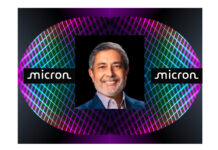Analysis: Pure Storage has won a deal to supply its proprietary flash drive technology to Meta, with Wedbush financial analysts seeing this as “an extremely positive outcome for PSTG given the substantially greater EB of storage PSTG will presumably ship.” The implication is that hyperscaler HDD purchases will decline as a result of this potentially groundbreaking deal.
The storage battleground here is for nearline data that needs to have fast online access while being affordable. Pure says its Direct Flash Modules (DFMs), available at 150 TB and soon 300 TB capacity points, using QLC flash, will save significant amounts of rack space, power, and cooling versus storing the equivalent exabytes of data in 30-50 TB disk drives.
A Pure blog by co-founder and Chief Visionary Officer John Colgrove says: “Our DirectFlash Modules drastically reduce power consumption compared to legacy hard disk storage solutions, allowing hyperscalers to consolidate multiple tiers into a unified platform.”
He adds: “Pure Storage enables hyperscalers and enterprises with a single, streamlined architecture that powers all storage tiers, ranging from cost-efficient archive solutions to high-performance, mission-critical workloads and the most demanding AI workloads.” That’s because “our unique DirectFlash technology delivers an optimal balance of price, performance, and density.”
A Meta blog states: “HDDs have been growing in density, but not performance, and TLC flash remains at a price point that is restrictive for scaling. QLC technology addresses these challenges by forming a middle tier between HDDs and TLC SSDs. QLC provides higher density, improved power efficiency, and better cost than existing TLC SSDs.”
It makes a point about power consumption: “QLC flash introduced as a tier above HDDs can meet write performance requirements with sufficient headroom in endurance specifications. The workloads being targeted are read-bandwidth-intensive with infrequent as well as comparatively low write bandwidth requirements. Since the bulk of power consumption in any NAND flash media comes from writes, we expect our workloads to consume lower power with QLC SSDs.”
Meta says it’s working with Pure Storage “utilizing their DirectFlash Module (DFM) and DirectFlash software solution to bring reliable QLC storage to Meta … We are also working with other NAND vendors to integrate standard NVMe QLC SSDs into our datacenters.”
It prefers the U.2 drive form factor over any EDSFF alternatives, noting that “it enables us to potentially scale to 512 TB capacity … Pure Storage’s DFMs can allow scaling up to 600 TB with the same NAND package technology. Designing a server to support DFMs allows the drive slot to also accept U.2 drives. This strategy enables us to reap the most benefits in cost competition, schedule acceleration, power efficiency, and vendor diversity.”
The bloggers say: “Meta recognizes QLC flash’s potential as a viable and promising optimization opportunity for storage cost, performance, and power for datacenter workloads. As flash suppliers continue to invest in advanced fab processes and package designs and increase the QLC flash production output, we anticipate substantial cost improvements.” That’s bad news for the HDD makers who must hope that HAMR technology can preserve the existing HDD-SSD price differential.
Wedbush analysts had a briefing from Colgrove and CFO Kevan Krysler, who said that Pure’s technology “will be the de facto standard for storage except for certain very performant use cases” at Meta.
We understand that Meta is working with Pure for its flash drive, controller, and system flash drive management software (Purity). It is not working with Pure at the all-flash array (AFA) level, suggesting other AFA vendors without flash-level IP are wasting their time knocking on Meta’s door. Also, Meta is talking to Pure because it makes QLC flash drives that are as – or more – attractive than those of off-the-shelf vendors such as Solidigm. Pure’s DFMs have higher capacities, lower return rates, and other advantages over commercial SSDs.
The Wedbush analysts added this thought, which goes against Pure’s views to some extent, at least in the near-term: “We would note that while PSTG likely displaces some hard disk, we also believe Meta’s requirements for HDD bits are slated to grow in 2025 and 2026.” Flash is not yet killing off disk at Meta, but it is restricting HDD’s growth rate.
Generalizing from the Pure-Meta deal, they add: “Any meaningful shift from HDD to flash in cloud environments, should seemingly result in a higher longer term CAGR for flash bits, a result that should ultimately prove positive for memory vendors (Kioxia, Micron, Sandisk, etc.)”








